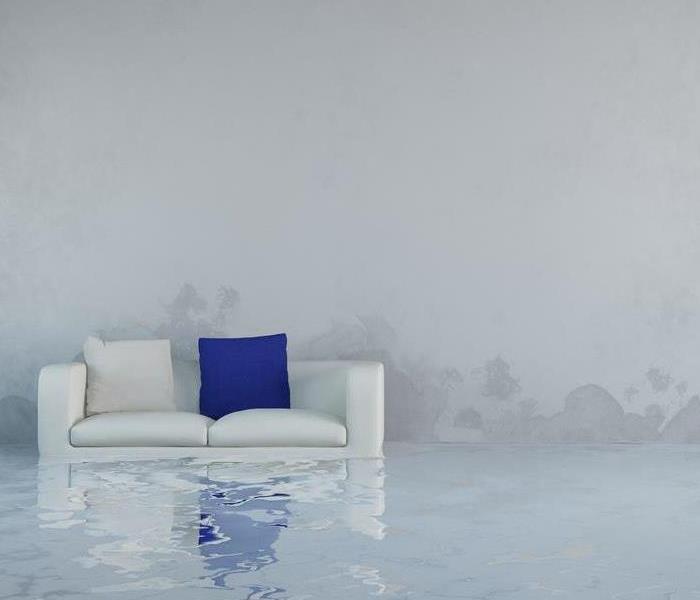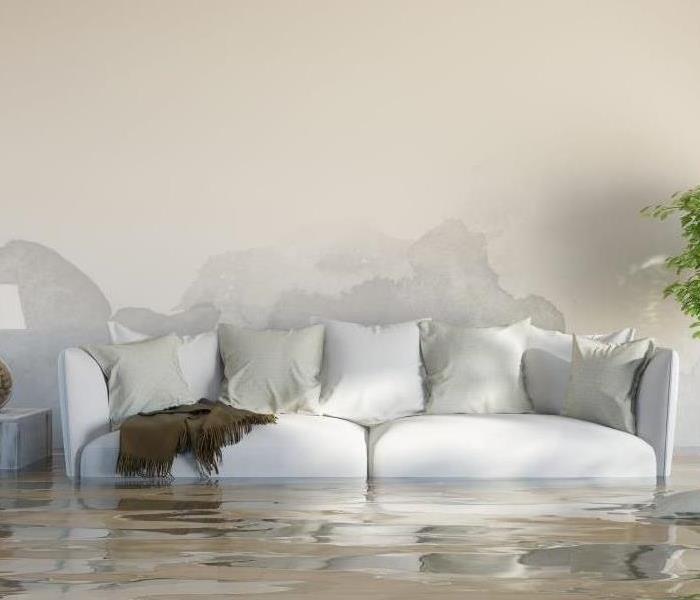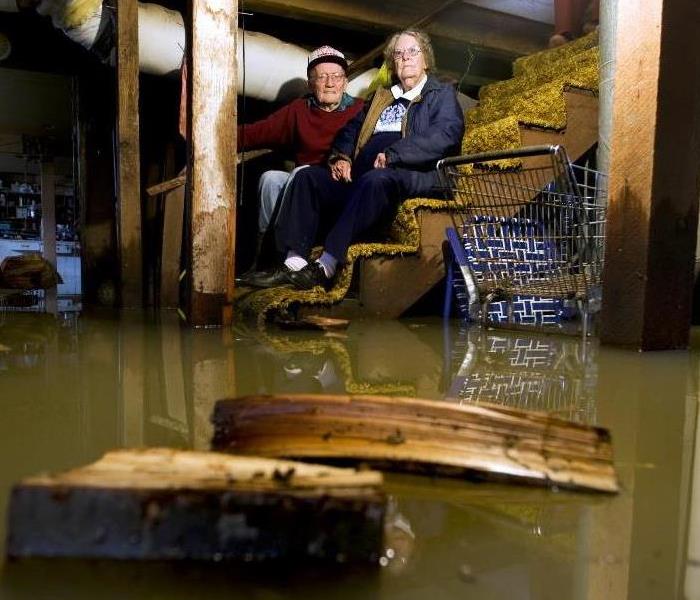Archived Water Damage Blog Posts
Spring Thaw
3/14/2022 (Permalink)
Another winter is coming to an end here in Michigan. As temps start to climb and the snow depth disappear many of us will start to look at what we can do around our homes to be prepared for the spring thaw.
After a long and cold winter the ground will still have frost in it and a fast warm up followed with rain can cause flooding. Here are some steps that can help prevent a flood in your home.
-Clean out gutters and Downspouts- also done in the fall to prepare for winter, there can still be leaves and debris that get in there and can cause a failure in the gutter system. If the snow melt and rain cannot properly flow it can backed up and flow into your house, down the walls, floors and into your basement.
-Sump Pump- be sure your sump pump is working properly and you have a backup in case power should failure. With the frost still in the ground, water can sit on top or worse, find a way into your basement. If this is the case, your sump pump working properly can get the water out of your basement and protect your belongings.
- Basement Storage- Good to have all year long, storing your items that in your basement in water proof storage and on shelving off of the floor. If flooding does occur, this will help save your items from being damaged beyond repair.
If a flooding event should happen at your property this spring, call the experts at SERVPRO of Mt Pleasant, Clare and Houghton Lake to get your properly dried out.
Boiler Failure
1/31/2022 (Permalink)
 Water Stained Walls from a Boiler Loss
Water Stained Walls from a Boiler Loss
Is your home or cabin's heating sources properly maintained?
It is important to have them properly maintained to avoid failure that can lead to water damage. The latest scenario is from a second home where the boiler failed. The water lines running through the baseboard heat froze during the cold, winter months Michigan is known for. Once temperatures rose and the pipes thawed, they split in a few different locations causing water to spill from the second floor all the way down to the crawl space affecting every room in the house. Due to this being a second home, the homeowner was not there at the time and was not able to turn the water off in a timely manner. The condensation from this caused the insulation in the walls to become soaked along with the river of water that was coming out of their crawl space.
SERVPRO of Mt Pleasant, Clare and Houghton Lake was able to get out to the property and get the water extracted and the walls opened up to allow the condensation to evaporate to limit further damage.
Water Backup from Power Failure
9/15/2021 (Permalink)
Over the past few months we have seen many homes around the area have water damage due to an extended power outage. Many of these backups have come from a Sump Pump failure and even when backups are put into place. What has ended up happening is that when power is out for a long period of time and it continues to rain, the battery backups run out of power as well causing the water to back up into the basement.
If something like this should happen at your property, you can rest assured that SERVPRO of Mt Pleasant, Clare, and Houghton Lake can assist you in getting your home dried out with the industries latest techniques and equipment.
Cottage Season
6/1/2021 (Permalink)
 Wet insulation from a water soaked crawl space
Wet insulation from a water soaked crawl space
The Unofficial start to summer, Memorial Day Weekend. Many of us travel to our favorite lake cottage or cabin. But what do you do when you walk in and discover that a pipe had burst and there is standing water all throughout your second home? This happened to a cottage owner as they came to check on their property and saw 2-3 inches of water in their cottage and a flooded crawlspace. SERVPRO of Mt. Pleasant, Clare, and Houghton Lake started taking care of the property right away by removing the insulation in the crawl space, removal of tile on the main floor and drying.
Call the professionals at SERVPRO of Mt. Pleasant, Clare, and Houghton Lake at 989-755-5065 to help get your property back in order.
When Frozen Pipes Burst, Now What?
2/11/2021 (Permalink)
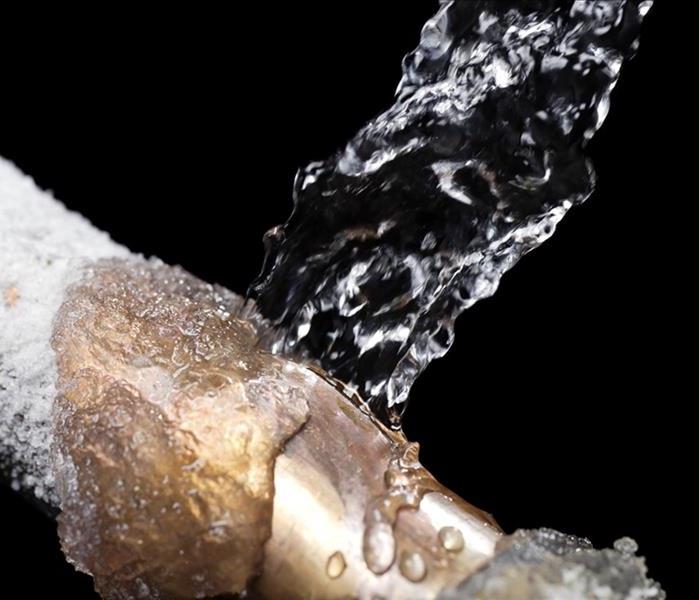 A frozen water line that froze and split causing a leak
A frozen water line that froze and split causing a leak
Sub zero temps have hit most of Michigan the last few weeks and with the bitter cold, it also brings freezing water lines. We see losses occur most of the time with second homes, cottages and maybe a vacant home that is for sale. It doesn’t take long for a pipe to freeze, then have a rapid warm up to thaw the pipe and unfortunately find out that it broke. Some times it can be as small as a pin hole that has had water dripping constantly or could be gushing water once it thaws. No matter the size, the damage it can be extensive if not found and taken care of in a timely matter.
Picture this, you walk into your cottage and find that you had a frozen pipe and it burst, what do you do now ?
1) Find the main water line and turn it off
2) Call SERVPRO of Mt Pleasant, Clare and Houghton Lake at 989-775-5065
3 Get in touch with a plumber and have them look over all your pipes to make sure there are no other broken pipes
Icicles, a beautiful winter sight or a sign of damage
1/19/2021 (Permalink)
Icicles are a sign that winter is here, they are nice to see but is it also a sign of potential damage?
Once you see icicles forming this could be a sign that ice dams are forming and can lead to further damage if not taken care of quickly.
Ice dams form because there is not adequate insulation in the attic. The warm air tries to escape through the roof and begins to melt the snow, as the water makes its way down to the edge of the roof it freezes causing an ice dam. We also see ice dams form when there is drastic temperature change from cold to warm and back to cold. The ice can damage gutters, shingles, and cause water damage in your house. Water can enter through your walls, into your insulation and if left long enough can cause microbial growth.
If you notice water damage call your local experts at SERVPRO of Mt. Pleasant, Clare and Houghton Lake at 989-775-5056 or visit us at SERVPROofmpchl.com
Categories of Water Damage
5/1/2019 (Permalink)
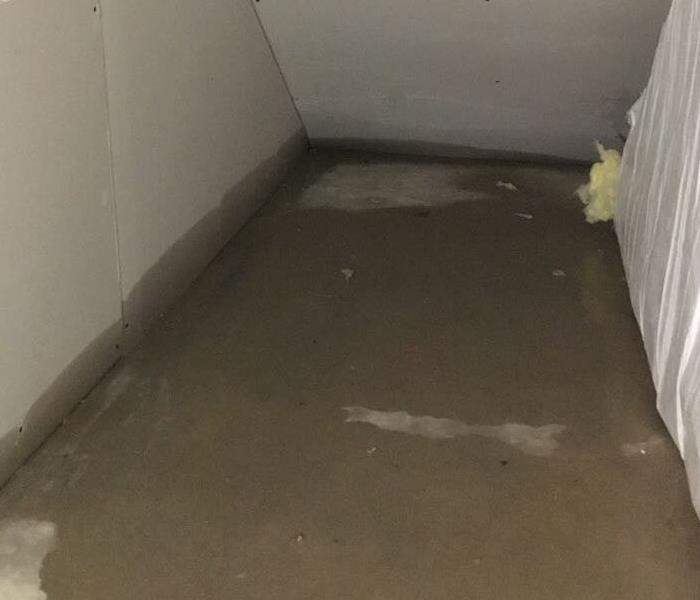 Water damage wicking up the drywall after a sump pump failure.
Water damage wicking up the drywall after a sump pump failure.
You may have had a small roof or plumbing leak. A bath tub overflow. A ruptured water heater. Or major storm flooding.
The amount of water is only part of the water-damage equation. The potential for deterioration and the extent of drying measures also depend on the rate of soak-in, the duration of exposure, and the rate of evaporation. And those in turn depend on the area and type of materials affected.
When moisture lingers for more than a day carpet, furniture, and building surfaces typically develop mold. Soon drywall swells and crumbles, wood swells, warps, and splits. Metals corrode. And given time even concrete weakens. So damage can range from minor discoloration all the way to structural problems. With SERVPRO the emphasis is on prevention and mitigation. Problems can become significant within 24-72 hours, so our focus is on getting things significantly dryer if not completely dry within that time frame.
IICRC Classes of Water Damage
The ANSI/IICRC S500 Standard and Reference Guide for Professional Water Damage Restoration is the gold-standard for the cleaning and restoration industry. It presents practical guidelines and procedures based on science and extensive experience. We talked about their categories of health hazards and the needs for surface cleaning and disinfecting before. Let’s now cover the degrees of leaks, spills, and water intrusions and their potential for damage. The IICRC divides them into four “classes.” It doesn’t giving any specific amounts of water as many other variables go into determining the proper water restoration measures.
Class 1
This class involves the least amount of water. It’s defined as affecting only part of a single room, with minimal wet carpet and affecting only low-permeable materials such as plywood and concrete sub-flooring. Resulting from things such a roof leak and rowdy kids in the bath tub, there’s minimal absorption and little moisture remaining after bulk water removal. So after mopping and blotting a natural slow rate of evaporation may be acceptable. Lifting carpet speeds drying and lets you determine if the sub-floor is excessively damp.
Class 2
Here there’s more water, and more gets absorbed by building materials. It’s defined as affecting an entire room or resulting in large areas of wet carpet, with water wicking upwards in walls at least 1 foot (but less than 2 feet) and moisture reaching structural materials. Class 2 water intrusions require bulk water removal, surface water extraction, and dehumidification for faster evaporation.
Class 3
With the most water and greatest absorption involved, Class 3 water restoration requires the fastest evaporation to head off deterioration. It’s defined as having flooring, sub-flooring, walls, and insulation saturated. With a source above the ceiling, that may be saturated as well. Advanced drying and dehumification methods via specialized equipment are critical.
Class 4
This last class is a special situation, typically the result of heavy natural flooding. There’s been enough water and time to saturate materials such as stone, concrete, brick, and hardwood. Highly aggressive methods to maintain very low specific humidity for longer periods than usual are required. Or the affected rooms may be considered a total loss if the structure has been severely compromised.
If you find yourself in need of a Certified Restoration Service to see our crew click here https://www.SERVPROmountpleasantclarehoughtonlake.com/employee-photos SERVPRO of Mount Pleasant, Clare and Houghton Lake are only a phone call away. We have a Representative available 24/7 to assist you in your time of crisis. Contact us @ 989-775-5065.
Mt. Pleasant, Clare & Houghton Lake 24 Hour Emergency Water Damage Service
4/24/2019 (Permalink)
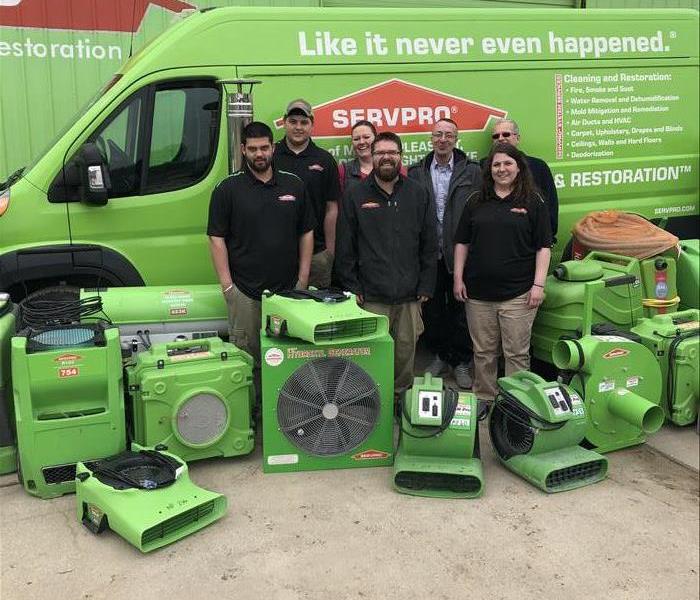 The crew here at SERVPRO of Mt.Pleasant, Clare, & Houghton Lake
The crew here at SERVPRO of Mt.Pleasant, Clare, & Houghton Lake
SERVPRO of Mt. Pleasant, Clare, & Houghton Lake is available 24 hours a day for water emergencies, large or small. When you are dealing with water damage, immediate action is crucial. A delay of just a few hours can greatly increase the severity of the water damage.
We Answer the Phone Ready to Help
Call Today - Mt. Pleasant, Clare, & Houghton Lake (989)802-9126
We understand that when you call us, you may be feeling confused, stressed, and vulnerable. You need an expert to guide you through this crisis. SERVPRO of Mt. Pleasant, Clare, & Houghton Lake has the specific water damage training and experience to help you through this tough time. We specialize in water damage restoration—in fact, it's the cornerstone of our business.
What to Expect
When you call, we will ask several questions regarding your water damage emergency. These questions will help us determine what equipment and resources to bring, including how many trained SERVPRO Professionals may be needed.
Our SERVPRO Representative will ask several questions:
- Your name and contact information
- Your insurance information (if applicable)
- The street address of the water-damaged home or business
- When did the flooding or water damage occur?
- What caused the water damage (if known)?
- Is there electricity available (on-site)?
Not All Water Damage Is Created Equal
4/28/2018 (Permalink)
How many of you remember as a kid playing in or around storm water drains or roadside ditches? It was fun, right? While you may have enjoyed splashing around in the waters, you might not realize that storm water like this may actually be contaminated with raw sewage, dangerous chemicals, or harmful bacteria and viruses capable of transmitting dangerous diseases to you.
In this same way, the harmful water that invades your home following a broken pipe, clogged toilet overflow, leaking dishwasher, overflowing washing machines, leaky roofs, or even foundation crack can be harmful.
Restoration Depends on Water Type
Specific steps must be taken to reduce property destruction, depending on the type of water damage. According to the Institution of Inspection Cleaning and Restoration Certification (IICRC), who sets the standards for the cleaning industry and water damage restoration training, there are three levels or types of water involved in damages. They include:
Category 1: Clean water
This water damage is from sanitary sources, such as an overflowing sink or tub, burst water pipes, failed supply lines to appliances, drinking fountains, or vertical falling rainwater.
Category 2: Grey water
This water is from sources that could make you uncomfortable or ill if ingested. Washing machine, dishwasher, or urine-tainted toilet overflows belong in this category.
Category 3: Black water
This is the worst classification of water and could cause severe illness if ingested. Sewer backups, flooded rivers, feces-tainted toilet overflows, or stagnant liquid that has bacterial growth are all examples of black water.
Let the Experts Save Your Home and Belongings
Seeping water damage is progressive, pervasive and can mean valuable objects or keepsakes may become permanently damaged. The professionals you find at a local SERVPRO are trained on how to handle the various types of water damage. Once they arrive on the scene at a home or business, they quickly assess the situation and start the restoration process in these three areas:
- Aggressive cleaning: Wall cavities and other surfaces are pressure washed with a detergent solution. Salvageable materials are flushed and thoroughly disinfected.
- Moisture detection: Not all water damage is visible to the naked eye. Water trapped in structural cavities may require sophisticated detection equipment to mitigate odors, prevent mold growth and minimize structural damage.
- Rapid Structural Drying: Mold begins growing on soggy surfaces within only 24 to 48 hours. Rapid drying, all the way down to the building’s substructure, is necessary to restore pre-flood conditions.
After your home floods, you may think your home and its contents are beyond hope, but many of your furnishings and belongings can be restored. With SERVPRO Of Mt.Pleasant, Clare and Houghton Lake's help, your flooded home can be cleaned up, dried out, rebuilt, and reoccupied sooner than you think.
If you find yourself dealing with water damage contact SERVPRO of Mt.Pleasant, Clare and Houghton Lake @ 989-775-5065 24/7 one of representatives are standing by.
Spring Time Means it's The Start of The Rainy Season.
4/28/2018 (Permalink)
Spring is finally here. Flowers are starting to bloom, but it also means it’s the start of the rainy season. While the spring can bring welcome relief after the long winter months, flooding is a real concern for homeowners. You don’t need to live in a flood zone to fall victim to flooding. It’s best for everyone to be prepared in case the worst happens.
While those in flood zones are more likely to experience some level of flooding, the reality is that it could occur anywhere. Changes in the area could create flood zones in areas that were deemed safe in the past and major weather storms could cause severe flooding that extends into zones that aren’t used to experiencing the flooding.
All homeowners should take the time to make sure they’re prepared just in case anything happens. It’s important for them to make sure they understand what can be done to prevent serious flood damage inside homes and to protect their belongings from these issues. Along with this, they’ll want to make sure they can prevent as much damage as possible to protect their family from safety issues that could occur if the home is flooded.
Know Your Risk Before Spring Begins
Even though a homeowner might have checked to see if they were in a flood zone when they initially bought the home and purchased homeowner’s insurance, it’s a good idea to recheck this occasionally. Flood zones can and do change. With growing cities, the arrangement of new homes and businesses could lead to a change in the areas that might be considered flood zones and could lead to more flood zones being created. Homeowners should make sure they know whether their home is now in a flood zone to ensure they can take the proper precautions if anything has changed since they bought the home.
Homeowners will also want to make sure they check the expected flood levels. This will give them a better indication of how high the flood waters could get in their home, so they can make sure anything important is above this level. Many homeowners will want to have their furnace, water heater, and other equipment inside the home placed above this level to minimize damages if flooding does occur.
Prepare with Building Supplies and Sandbags
Sandbags can often be obtained nearby when there is the potential for a flood, but the lines to obtain sandbags can be long and the amount a family can take for their home may be limited. Homeowners can keep their own sandbags on hand to use if there is a threat of flooding in their area. The sandbags should be placed where needed to help keep flood waters from getting into the home when there is a chance of flooding.
Along with purchasing and preparing sandbags, homeowners can purchase building supplies to keep on hand. It’s a good idea to secure these up and out of the way in case flooding does occur. Having a few stud boards, plywood boards, tarps, nails and more on hand can help with emergency repairs if there is the potential for flooding or help create a way to protect some of the items in the home from damage. Additionally, there could be a shortage of building supplies in the immediate aftermath of the flood, so having these supplies on hand could lead to faster repairs if anything is damaged.
Keep Important Documents and Irreplaceable Items Above Flood Levels
Homeowners who know their flood levels will want to prepare by placing any irreplaceable documents or items in boxes that can protect them. These boxes should be placed above the potential flood levels but should be easy to grab in case of an evacuation. This will help homeowners ensure identifications, passports, deeds, insurance documents, and more are both safe from the flood and easily accessible if a flood does impact the home or an evacuation is necessary.
Prepare an Emergency Plan in Case Flooding Occurs
Families should always have a plan in place to deal with potential natural disasters, and flooding is no exception. Even if the home is in an area that is not likely to flood, parents will want to speak with their children about what could happen in a flood, what they should do, and how they can stay safe. This should include how to prevent injuries or illnesses from contaminated flood water as well as what to do if an evacuation is needed and what should be grabbed from the home if they need to evacuate.
Act Fast to Minimize Damage After a Flood
If a home is impacted by a flood, the first step will be to assess the damage and remove all water from the home. This can be done by SERVPRO to ensure it’s done properly. At this point, the homeowner will want to start removing anything damaged from the home and repairing anything that needs to be repaired. Flood waters, even after the majority is removed from the home, could cause mold growth because of the water that was inside the home and that soaked into the building materials.
The faster the home is repaired, the lower the chance for mold to grow. Additionally, the damage from the water won’t have the chance to spread to more areas of the home if it’s removed as quickly as possible. The emergency building supplies purchased before the chance of flooding could help the homeowner repair their home faster and enable them to minimize the potential damage that could occur while they wait for help with larger repairs.
Spring can be the start of beautiful weather and a welcome change from the dreary winter, but it can also bring significant flooding to many areas. Homeowners can use these tips to ensure they’re prepared for flooding and know how to protect their home, belongings, and family from any potential floods. Start preparing your home today to ensure you and your family are as safe as possible in case anything happens.
If you find yourself in the need of a Water Restoration Company, SERVPRO of MT.Pleasant,Clare and Houghton Lake are here to assists you 24/7. Simply call 989-775-5065 and one of our Representatives will be glad to help.
Steps to take if your basement floods.
4/11/2018 (Permalink)
When a basement floods it is a stressful, confusing event which can take a lot of time, money and effort to bring your home back to where it was before the water damage. Whether the damage is caused by a broken water pipe, heavy rains, a failed sump pump or swelling of ground water complicate things further as they all require different approaches to make it "Like it never even happened."
Fortunately here at SERVPRO of Mt.Pleasant, Clare and Houghton Lake we have been able to help families with flooded basements all around Roscommon,Clare,and Mt.Pleasant and are ready to help you. In this blog we will seek to give you general advice for handling flooded basements but do remember our emergency line is open 24/7 and we are here to help you with specific advice for your flooded basement.
Safety for you and your family should be your first concern when you find out your basement has flooded. There are two main safety concerns in every water intrusion situation Electrical and Tripping hazards are the most prevalent source of injury in our industry.
- Never go into a flood damaged basement with standing water which has submerged outlets or other active sources of electricity. Wait for the water to be pumped out by a professional, such as SERVPRO, if you can’t safety do that yourself.
- Most home electronic systems and devices can be damaged from being submerged or exposed to water. Don’t us devices or outlets that have been exposed to water even after the water has been pumped out.
- It is not just the water but also the particulates in the water which will stay behind even after the water has been removed that can damage electrical systems and equipment.
- Not everything breaks immediately it can take time after electrical system is exposed to water before it breaks or becomes unsafe.
- Pay attention to where you are walking, many restoration professionals have hurt themselves walking across different materials (such as carpet to tile) because they didn’t expect the different in friction when these materials are wet.
- If you are removing any materials from your basement remember that wet materials can be VERY heavy.
- Keep out of rooms where ceilings are sagging
When you have accounted for safety you can move on to being proactive about your home and belongings before our restoration technicians get there. Every minute counts which is why we respond 24/7 to emergencies and why anything you do until we get there can help protect your home.
- If possible find the source of water intrusion and stop the flow of water into your property. Check your sump pump to make sure it is working. They sometimes get unplugged or the arm gets stuck. If a pipe is broken shut off your water valve to your home.
- Remove as much water as you can. Using a shop vac, mopping or blotting possible. The less water which is allowed to soak into your furniture, walls and carpet the better off you will be.
- Move furniture off of wet carpet and wipe the legs or bottoms before placing in an unaffected area. Wet furniture, especially wood and metal, can stain carpet very quickly.
- If you cannot remove furniture from an affected area you can place foil or woodblocks between furniture legs and the carpet to prevent staining.
- Remove colored rugs from wet carpeting so their coloring doesn’t bleed onto the carpet.
- Turn on air conditioning for maximum drying in the summer.
Remember that our emergency line 989-775-5065 is always answered by one of the restoration professionals here at SERVPRO so we can give you advice specific to your situation. We are always Here to Help.




 24/7 Emergency Service
24/7 Emergency Service




